Posted by: Northwest Eye in General on November 2, 2025
Overview
Conjunctival chemosis can be concerning, and it’s important to understand what’s happening. This condition arises from swelling of the conjunctiva, often due to allergies, infections, trauma, surgical complications, or even excessive eye rubbing. We understand that experiencing these symptoms can be unsettling, and recognizing them is the first step toward feeling better.
It’s common to feel anxious about what this means for your health. The good news is that there are effective treatments available. Depending on the severity and underlying cause, options may include:
- Cold compresses
- Antihistamines
- Eye drops
- Surgical intervention
We’re here to help you through this process and ensure you receive the care you need.
If you notice symptoms like redness, swelling, or discomfort, don’t hesitate to seek help. Remember, you’re not alone in this journey. Many others have faced similar challenges and found reassurance in understanding their condition. Taking action now can lead to a smoother recovery.
In summary, recognizing conjunctival chemosis and its causes is crucial. By seeking appropriate treatment, you can alleviate your symptoms and regain comfort. We encourage you to reach out to a healthcare professional who can guide you through your options and support you every step of the way.
Introduction
Conjunctival chemosis can understandably provoke concern due to its visible effects. This condition involves the swelling of the conjunctiva—the delicate membrane that coats your eye. We know that seeing this change can be alarming, and understanding this phenomenon is crucial. It can stem from various causes, including:
- Allergies
- Infections
- Surgical complications
It’s common to feel uncertain about what this means for your eye health. Recognizing the symptoms early is key, and knowing how to navigate treatment options can help you reclaim your well-being. This article delves into the intricacies of conjunctival chemosis, offering insights into its causes, symptoms, and the best strategies for management. We are here to help you through this process.
Define Conjunctival Chemosis
Conjunctival chemosis, which often raises concern for many, is defined as the swelling of the conjunctiva—the transparent membrane that covers the white part of the eye. This condition can manifest as conjunctival chemosis, which appears as a blister-like bulge due to fluid accumulation and often indicates irritation or inflammation. We understand that conjunctival chemosis can be alarming, and it’s important to know that it can arise from various underlying factors, including:
- Allergies
- Infections
- Trauma
Interestingly, the occurrence of eye swelling during cataract surgery has been recorded at around 9.17%. This statistic highlights how common this issue can be in surgical environments. Symptoms may include noticeable swelling, discomfort, and visual disturbances, which can significantly impact your quality of life. As one ophthalmologist noted, “Conjunctival chemosis can impede the entry of surgical instruments into the eye, complicating procedures.”
We want to reassure you that grasping these elements is essential for the proper identification and handling of conjunctival chemosis. If you or a loved one is experiencing these symptoms, please know that we are here to help you through this process.
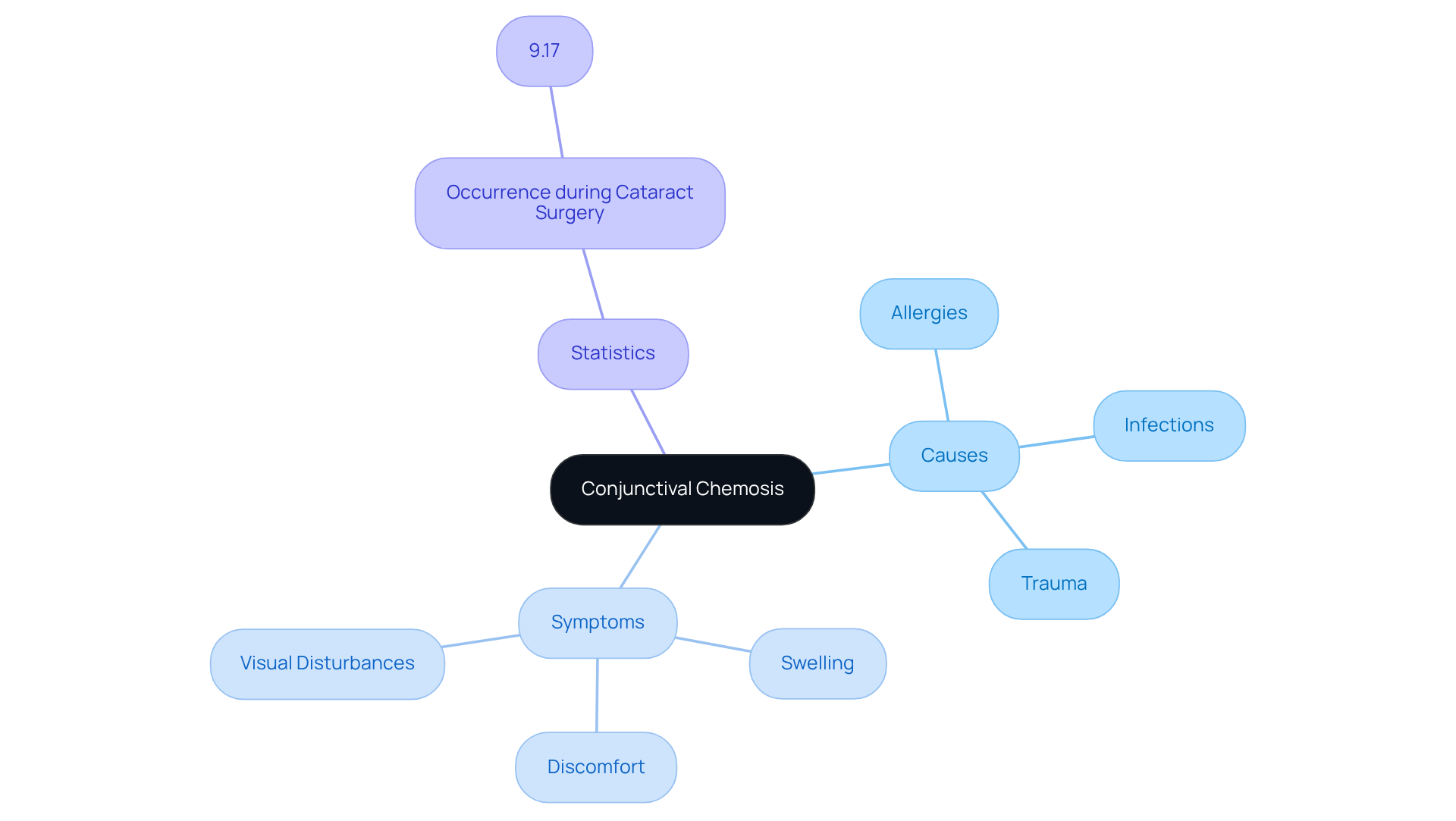
Identify Causes of Chemosis
Understanding the various causes of conjunctival chemosis can help you feel more in control of your eye health. Here are some common reasons:
-
Allergic Reactions: Many people experience allergic reactions to common allergens like pollen, pet dander, and dust. This inflammation can lead to chemosis. In fact, about 40% of North Americans deal with some form of allergic eye disease. Allergists explain that the IgE-mediated response is a key factor in these reactions, resulting in swelling and redness. We understand how frustrating this can be.
-
Infections: Viral or bacterial infections, such as conjunctivitis, can also cause swelling. Studies show that around 80% of acute conjunctivitis cases are viral, often sharing symptoms with allergies, which can make diagnosis tricky. It’s common to feel overwhelmed when symptoms overlap, but knowing this can help you seek the right care.
-
Trauma: Physical damage to the eye or eyelid can lead to swelling. This might occur from accidents or even excessive rubbing, which irritates the conjunctiva and causes fluid buildup. We know how concerning this can be, and it’s important to take care of your eyes.
-
Surgical Complications: If you’ve had eye surgery, such as blepharoplasty, temporary swelling can occur. Conjunctival chemosis is a known complication that can occur after eyelid surgery, and while it may be alarming, management typically involves simple eye drops or, in some cases, further surgical intervention if it doesn’t resolve. Remember, you’re not alone in this experience.
-
Excessive Eye Rubbing: Rubbing your eyes too much can irritate the conjunctiva, leading to swelling. Allergists often recommend avoiding this habit to prevent worsening symptoms. We understand that it can be hard to resist, especially when your eyes feel uncomfortable.
Grasping these factors is essential for both prevention and treatment. Taking prompt action can significantly lessen the impact of eye swelling on your quality of life. We are here to help you through this process and ensure you receive the care you need.
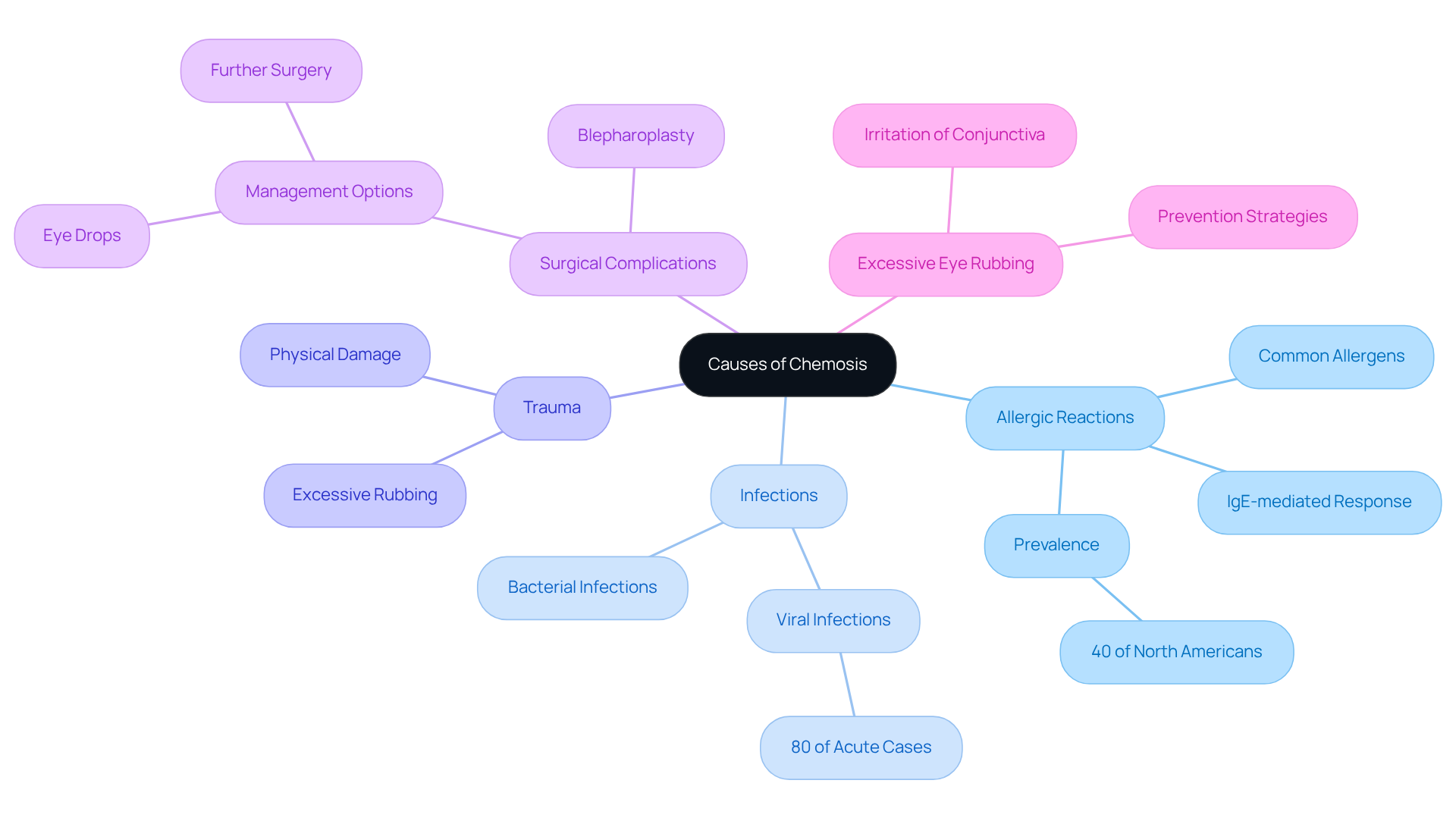
Recognize Symptoms of Chemosis
Recognizing the symptoms of eye swelling is essential for timely diagnosis and treatment. We understand that noticing changes in your eyes can be concerning, so let’s explore some key signs to look out for:
- Swelling: You might see a jelly-like bulge on the conjunctiva, which can be quite noticeable.
- Redness: The affected area often appears red or inflamed, signaling irritation.
- Itching or Irritation: Many people describe a gritty sensation in their eyes, which can be uncomfortable.
- Watery Eyes: Increased tear production is common as your body responds to irritation.
- Light Sensitivity: It’s not unusual to feel discomfort in bright light, which can be bothersome.
Identifying these signs is crucial, as they can lead to quicker diagnosis and intervention. For example, if you’re experiencing significant swelling and light sensitivity, it’s important to seek medical attention right away to avoid complications. Eye care specialists emphasize that early recognition of these symptoms can greatly improve treatment outcomes, especially when underlying conditions like allergies or infections are involved.
Conjunctival chemosis, or swelling of the conjunctiva, can last from a few days to weeks, depending on the cause. If you’re dealing with mild allergy-related swelling, over-the-counter medications like diphenhydramine can help alleviate discomfort. However, if you find it difficult to close your eye completely, please seek medical attention promptly. Applying cold packs for 20 minutes can also be beneficial in reducing swelling related to eye irritation.
Understanding these signs not only helps you manage your health but also empowers you to seek appropriate care when needed. Remember, we are here to help you through this process.
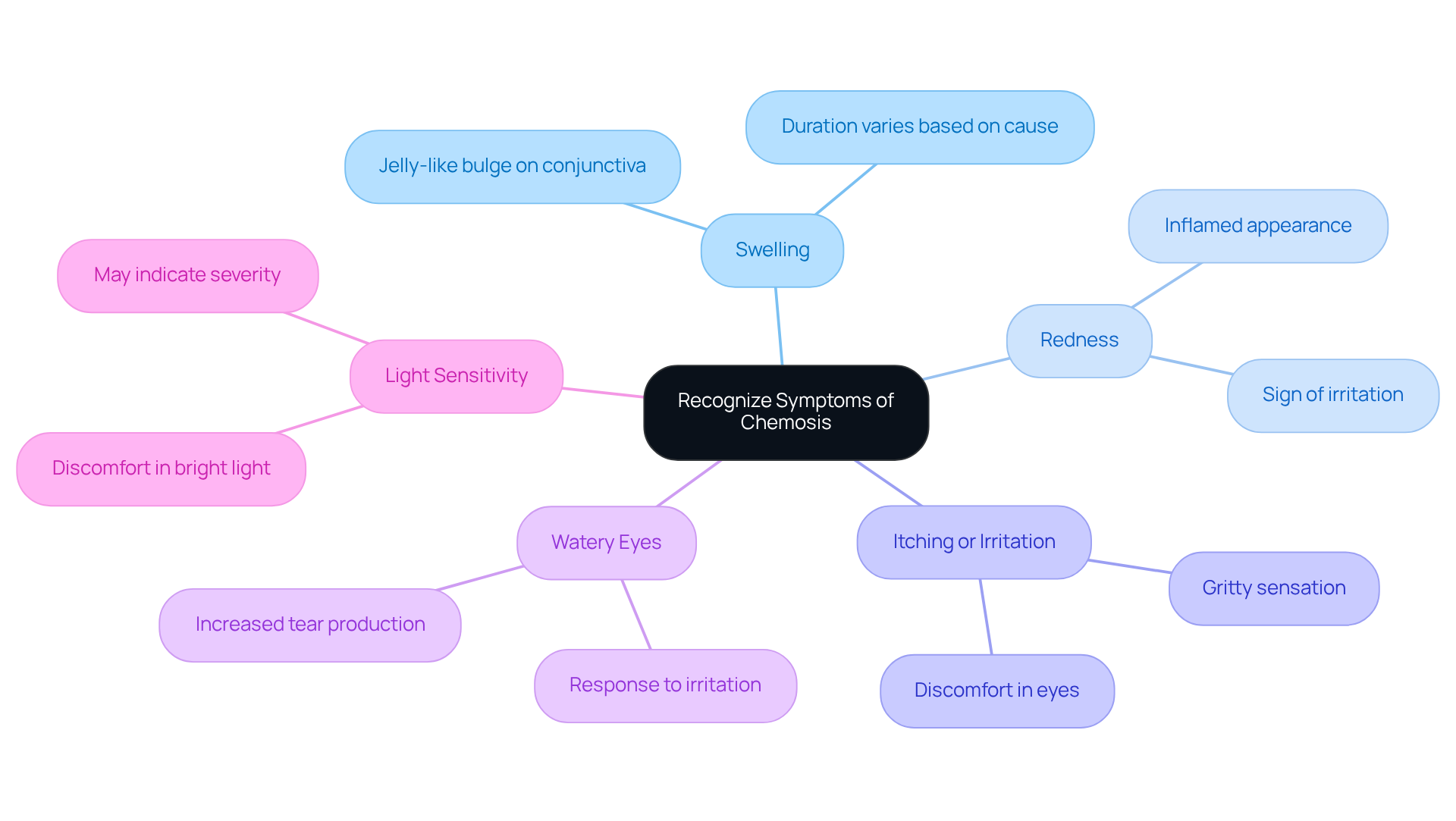
Diagnose Chemosis Effectively
Diagnosing conjunctival chemosis may seem overwhelming, but we are here to guide you through the process. This process involves a systematic approach that includes several key steps:
-
Patient History: Gathering detailed information about your symptoms, their duration, and any potential triggers is crucial. Common reasons for eyelid swelling, such as conjunctival chemosis, include allergies, viral or bacterial infections, and post-surgical complications. We understand that this can be concerning, and knowing the cause is the first step towards feeling better.
-
Physical Examination: An ophthalmologist will conduct a thorough assessment of your eye, checking for swelling, redness, and other signs of conjunctival chemosis. This examination is essential for understanding your condition fully.
-
Visual Acuity Test: This test is vital for assessing your vision and ruling out other possible complications that may accompany the swelling. Studies show that visual acuity tests are highly accurate in diagnosing related conditions, providing reassurance during this process.
-
Additional Tests: In some cases, further diagnostic procedures like eye scrapings or cultures may be necessary to identify underlying infections. We know that additional tests can feel daunting, but they are important for your recovery.
As Dr. Ann Marie Griff wisely states, “If you treat the underlying cause, you should make a full recovery.” This comprehensive diagnostic approach not only ensures a precise identification of your condition but also informs the treatment plan that will enhance your outcomes. Remember, managing the underlying causes is vital to prevent recurrence. We are here to help you through this process.
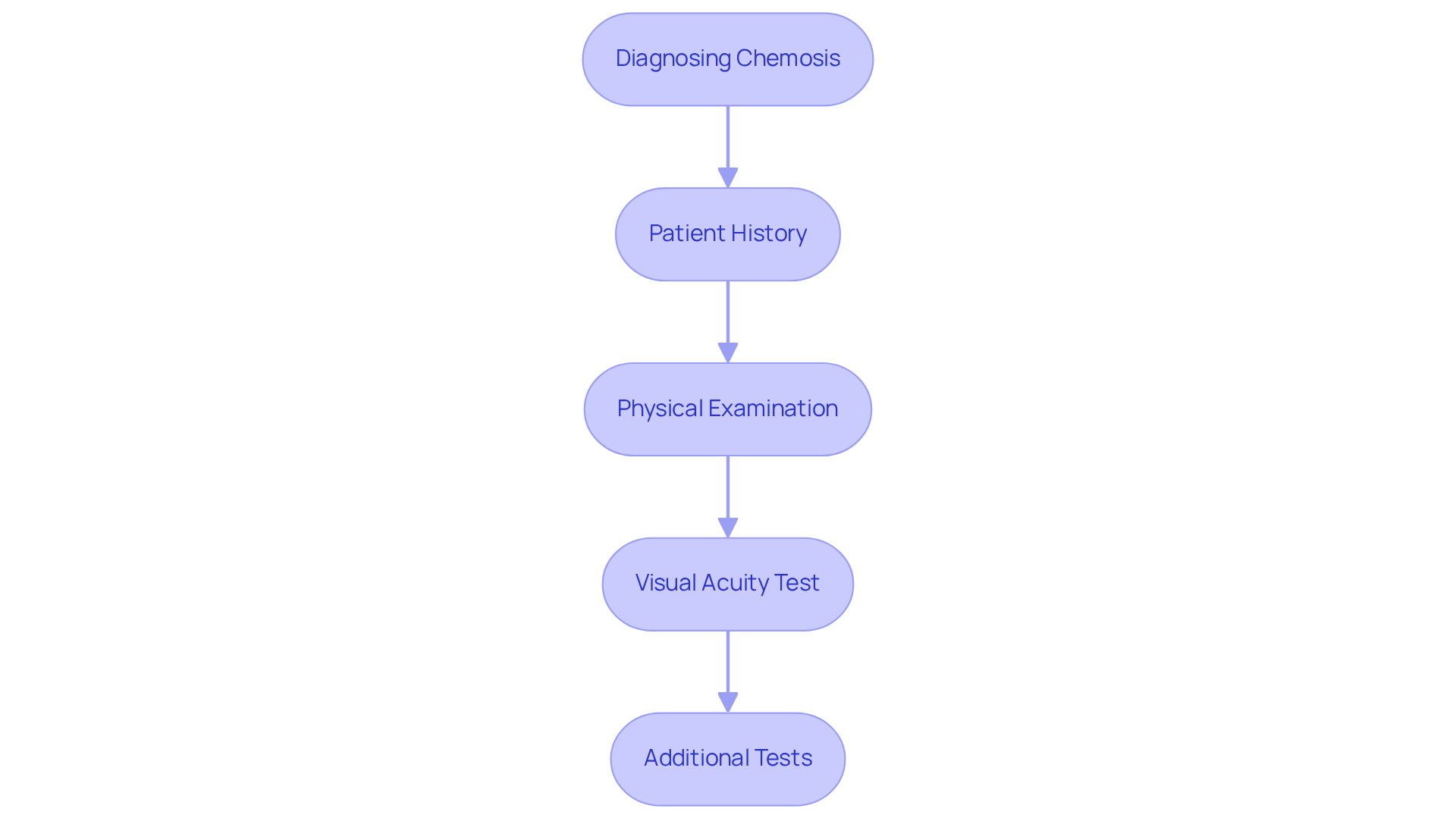
Explore Treatment Options for Chemosis
If you’re dealing with conjunctival chemosis, know that there are various treatment options tailored to the underlying cause and severity of your condition. Here’s a look at some effective management strategies that can help you feel better:
- Cold Compresses: Applying a cool cloth to the affected area can significantly reduce swelling and discomfort, offering immediate relief.
- Antihistamines: Both oral and topical antihistamines can effectively address issues related to allergic reactions. Many patients find that these medications lead to a noticeable reduction in symptoms, with success rates often exceeding 70% in managing conjunctival chemosis.
- Eye Drops: Your doctor may prescribe lubricating or anti-inflammatory eye drops to soothe irritation and reduce inflammation. Topical antihistamines, like olopatadine, are commonly recommended for their effectiveness and safety.
- Antibiotics: If an infection is present, antibiotic eye drops are crucial for treatment. Typically, these are administered over a course of 7 to 10 days to ensure complete resolution.
- Surgical Intervention: In more severe or persistent cases, surgical options such as conjunctivoplasty may be necessary to restore normal eye membrane function and appearance.
We understand that navigating these options can feel overwhelming. Consulting with an ophthalmologist is essential to determine the most appropriate treatment plan based on your individual circumstances. As specialists in the field emphasize, “A precise understanding of the immune mechanisms responsible for eye inflammation is needed to support ongoing research for potential therapeutic targets.” This highlights the significance of personalized care in effectively managing conjunctival chemosis. Remember, we are here to help you through this process.
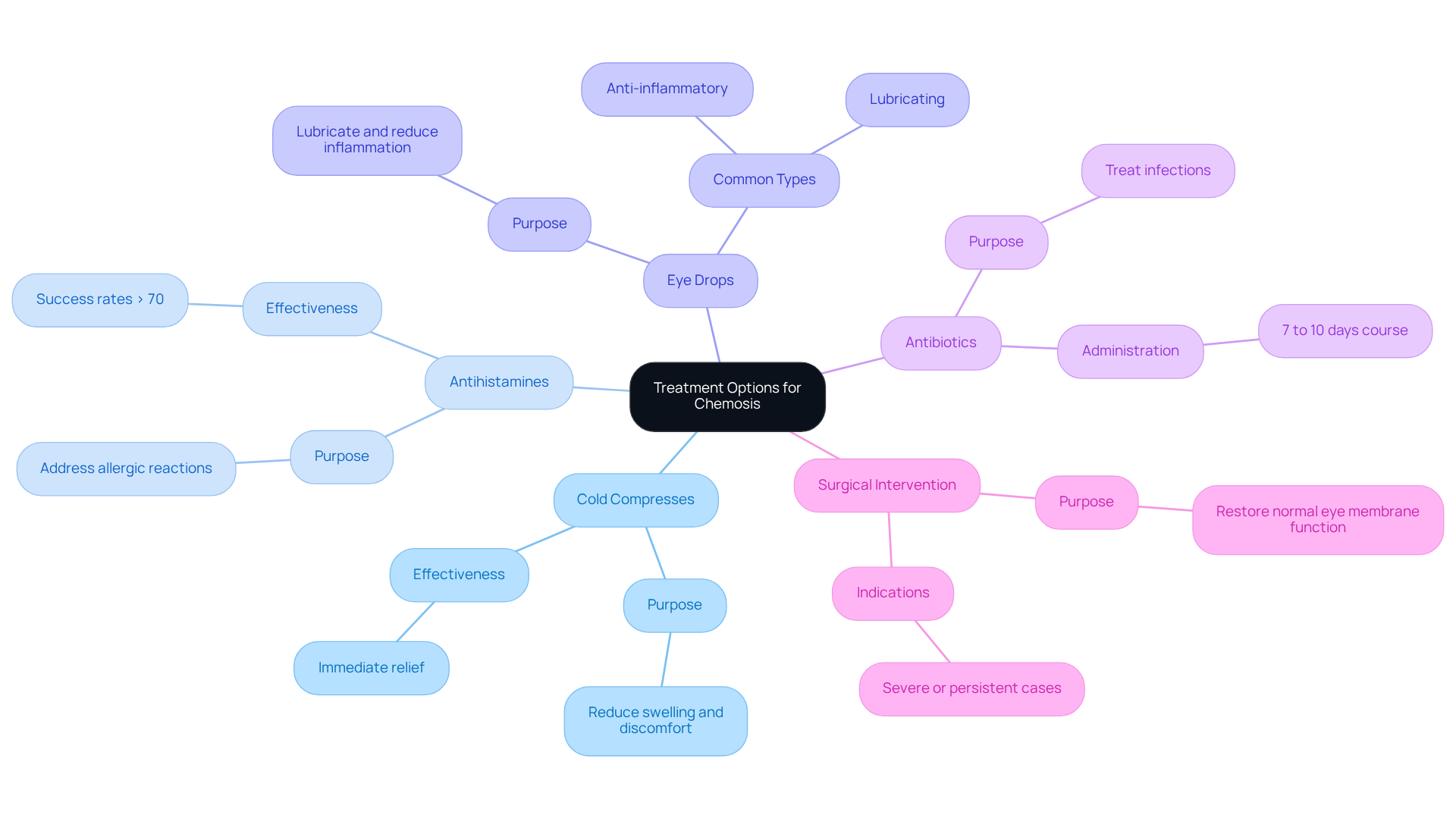
Conclusion
Conjunctival chemosis is a condition that can be concerning, characterized by the swelling of the conjunctiva. It often arises from various factors, including:
- Allergies
- Infections
- Trauma
- Surgical complications
Understanding this condition is essential, as it can lead to discomfort and visual disturbances that impact your daily life. Recognizing the symptoms and knowing when to seek medical attention can significantly enhance treatment outcomes and overall eye health.
We understand that it can be overwhelming to navigate the causes of conjunctival chemosis. Allergic reactions, infections, and even excessive eye rubbing can contribute to this condition. That’s why it’s crucial to accurately diagnose the issue through a thorough patient history and physical examinations. This ensures that the right treatment is administered. Treatment options can range from simple cold compresses and antihistamines to more serious interventions like surgery, depending on the severity of the condition.
Ultimately, being informed about conjunctival chemosis empowers you to take proactive steps in managing your eye health. Whether you’re experiencing symptoms or seeking preventive measures, understanding the underlying causes and available treatments is vital. If you find yourself facing this condition, consulting with an eye care professional is essential. We are here to help you through this process, ensuring proper care and recovery. Prioritizing your eye health and seeking timely interventions can make a significant difference.
Frequently Asked Questions
What is conjunctival chemosis?
Conjunctival chemosis is the swelling of the conjunctiva, the transparent membrane that covers the white part of the eye. It appears as a blister-like bulge due to fluid accumulation and often indicates irritation or inflammation.
What are the common causes of conjunctival chemosis?
Common causes include allergic reactions, infections (such as viral or bacterial conjunctivitis), trauma to the eye or eyelid, surgical complications, and excessive eye rubbing.
How prevalent is conjunctival chemosis during cataract surgery?
The occurrence of eye swelling during cataract surgery has been recorded at around 9.17%, highlighting its commonality in surgical environments.
What symptoms are associated with conjunctival chemosis?
Symptoms may include noticeable swelling, discomfort, and visual disturbances, which can significantly impact quality of life.
How can allergic reactions lead to conjunctival chemosis?
Allergic reactions to common allergens like pollen, pet dander, and dust can cause inflammation, resulting in chemosis. About 40% of North Americans experience some form of allergic eye disease.
What role do infections play in conjunctival chemosis?
Viral or bacterial infections, such as conjunctivitis, can cause swelling. Approximately 80% of acute conjunctivitis cases are viral, often sharing symptoms with allergies, complicating diagnosis.
Can trauma to the eye cause conjunctival chemosis?
Yes, physical damage to the eye or eyelid, including accidents or excessive rubbing, can irritate the conjunctiva and lead to fluid buildup, resulting in swelling.
What should one expect after eye surgery concerning conjunctival chemosis?
Temporary swelling, including conjunctival chemosis, can occur after eye surgeries like blepharoplasty. Management typically involves simple eye drops or, in some cases, further surgical intervention if it doesn’t resolve.
How can excessive eye rubbing contribute to conjunctival chemosis?
Rubbing the eyes too much can irritate the conjunctiva, leading to swelling. It is often recommended to avoid this habit to prevent worsening symptoms.






